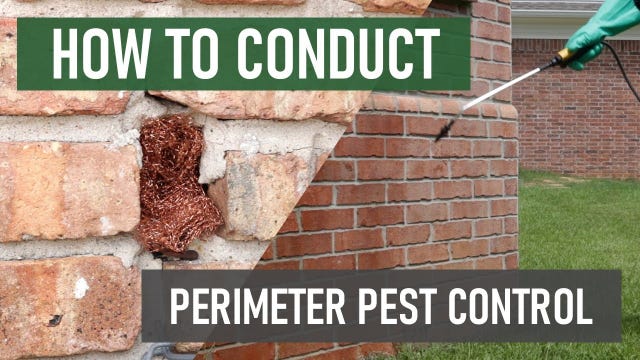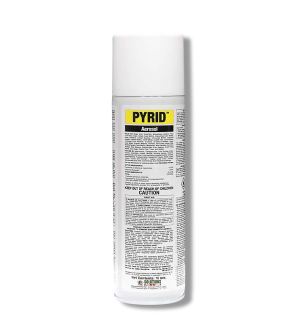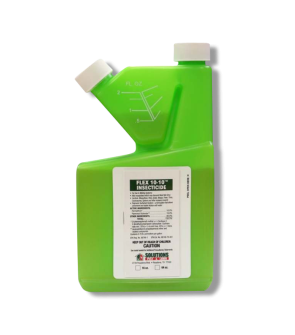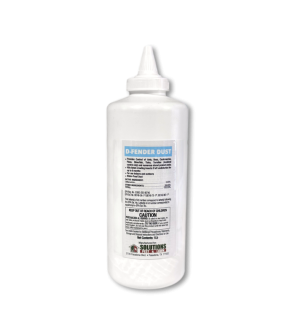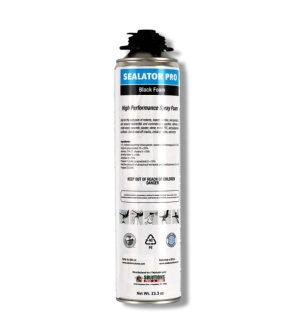Gain access to personalized product screening, the best pricing, rewards, and more!
Most Effective Products
How to Keep Bugs Out of Your Home Through Perimeter Pest Control
This page is a general perimeter pest control spray guide. Using the tips and methods suggested, you can prevent bugs from coming into your home and know when to apply a perimeter pest control application. Follow this guide and use the recommended methods and products, and we guarantee complete control of indoor pest infestations.
Most pests live on the outside of your home in the yard, but conditions indoors can attract these pests to travel inside. Once inside, they can get into your food, cause structural damage to areas such as sub-flooring and walls, spread disease, and potentially bite or sting you, your family, and your pets. Some pests enter through open doors and holes in window screens, but an even greater amount of pests may enter through any other openings from the outside.
Keeping pests out of your home is important; each season brings unique pest challenges. Treating the outside perimeter of your home with a perimeter pest control application is an excellent method of preventing pests like flies from gathering around windows, ants creating trails to and from your structure, and termites from swarming or breeding near your home.
Battling an insect infestation can be frustrating, expensive, and time-consuming, but it can be avoided with perimeter pest control treatments. Conduct perimeter pest control around your home or structure to ensure these pests stay out of your home. Learn more about perimeter pest control through our DIY guide and use the recommended products to prevent unwanted indoor pests and to keep your house pest-free.
What is Perimeter Pest Control
Perimeter pest control focuses on creating a barrier on the outside of your home or structure to stop unwanted pests like termites, millipedes, crickets, spiders, cockroaches, ants, mice, rats, silverfish, stink bugs, and more before they enter your property and start causing problems. Although it focuses primarily on keeping pests out and away from your home, it also helps protect your shrubs, bushes, and ornamental landscape from pest infestations.
The perimeter of your home is considered any area next to the structure, including the lawn, landscape bed, deck, porch, garage, windows, door frames, crawl space openings, and the walls/edges of the building itself. Typically, perimeter pest control is applied no more than 3 feet up and 3 feet from the structure to be treated.
This form of pest control involves creating physical barriers, such as copper mesh or foam, and chemical barriers with a long-lasting insecticide. A good pest control plan will use physical and chemical barriers to prevent most pests from invading.
When Should I Spray The Perimeter Of My House for Bugs
Depending on your pesticide, a perimeter pest control spray only lasts a few weeks or months. For this reason, your home's perimeter should be sprayed quarterly, about 2 to 3 times a year, depending on your location.
Preferably, your home should be treated at least once every 90 days, depending on the pest and where you live in the United States. Generally, spray once during the early spring and summer when the weather starts to warm and pest populations remain low, and again in the fall when temperatures drop and before the first frost in your region.
What Are the Benefits of Perimeter Pest Control
- These treatments, whether granular or liquid, help to fend off a variety of pests from entering your property and home. Your location, pesticide, and application timing will dictate which pests come into contact with treated areas.
- Takes place outdoors - keeping insecticides and pesticides out of the way of your family and pets.
- Application is easier than controlling pests indoors as they can hide in various structures, appliances, cracks, and crevices.
- Protects landscapes, plants, and ornamental gardens from being destroyed by pests like aphids or clover mites.
How to Prepare Your Home For Perimeter Pest Control
To help prevent pests from entering your home, perform the following basics before pest control treatments occur.
Close Off Pest Entry Points
Examine the outside perimeter of your home for holes, cracks, gaps, crevices, or other openings where pests could use to travel inside.
Seal entry points around window and door frames with an expanding foam product like Solutions Sealator Pro Black Foam, and larger gaps can be plugged with copper mesh. This expandable sealant spray foam creates airtight seals to block pests from entering structures without damaging building elements.
You will need to install the Solutions Sealator Pro Black Foam on a pro-grade foam application gun, such as the Solutions Polyurethane Foam Gun.
To use this product with the Solutions Polyurethane Foam Gun, remove the lid from the foam canister and turn the foam gun upside down. Quickly screw the Solutions Sealator Pro Black Foam onto the foam guns adapter until secure. Once both products are connected, you will shake up and down about 20 times. Loosen the gun control knob and begin to apply the Solutions Sealator Pro Black Foam to thin cracks and crevices like joints and around window and door frames.
Install door sweeps and weather stripping around doors that lead outside, including windows. Repair or seal large openings and gaps around pipes, plumbing, window screens, and door screens.
Trim Overgrown Vegetation
Next, check your ornamental bushes and shrubs along the structure and trim down any overgrowth. Overgrown vegetation can create direct pathways for pests like ants and termites to invade. Squirrels could even access your roof via untrimmed tree branches. Pests like mosquitoes use overgrown plants as shelter.
Prune shrubs, tree limbs, and other plants until they do not touch the side of your house or hang above it.
You will also want to keep your lawn mowed to a reasonable height to reduce hiding spots and discourage pests from harboring near your home. Different grass species will have different preferred mowing heights. Cutting your grass the day of or a few days before a perimeter pest treatment can allow insecticides to reach pests more easily.
Clear Away Plant Debris
Piles of yard waste can provide another hiding place for pests from insecticide applications and promote conditions for breeding. Rake away fallen plant debris from fallen branches, leaves, pine needles, grass clippings, twigs, limbs, rocks, and other foliage.
Clear away any mulch, plant bedding, and rocks at least 6 inches from your home's foundation. Eliminating these conditions can help to reduce moisture, attractants for pests, and increase perimeter pest treatment application.
Minimize Moisture
Standing water around any part of your home is a breeding ground and food source for pesky pests. This is the case for downspouts and gutters, which can collect water and plant debris. Ensure downspouts are draining water away from your home's foundation.
With a glove-covered hand, remove plant debris that has collected in rain gutters. If you have sprinklers on your lawn, point them away from your home and more towards your lawn.
How Do You Spray the Perimeter of a House for Bugs
After cleaning the yard and sealing any openings to your home, you must apply a residual insecticide like Supreme IT to create a chemical barrier around it.
Supreme IT is a broad-spectrum insecticide labeled to control over 70 types of pests on contact. It also provides residual repellency around homes, turfgrass, and other ornamental plants adjacent to the structure for up to 90 days after application.
Determine how much Supreme IT to use by measuring the square footage of the treatment area. Measure the length and width of the treatment area in feet, then multiply them together (length X width = square footage).
You must mix this product with water before applying it, so we recommend mixing and applying your solution with a handheld pump sprayer.
To stop general pests from entering your home, apply 0.33 to 1 fl. oz. of Supreme IT with 1 gallon of water over a treatment area of up to 1,000 sq. ft.
When your solution is ready, conduct a barrier application around the perimeter of your structure. First, spray any entry points like doors, windows, and other voids that pests can use to invade with a coarse spray pattern. Then, spray your structure's outer perimeter by spraying 3 feet up the structure and 3 feet out.
The best time to spray this product is during calm weather when rainfall is not expected 24 hours after application. Keep children and pets away from treated areas until the spray has dried. Labeled pests that come in contact with the product or its residual will impact their nervous systems and die in several hours.
We recommend you make applications once every 3 months to maintain protection year-round.
Pests cannot invade your home once you have applied physical and chemical barriers. Remember that pests can have been inside before your barrier application, so we recommend you treat indoors as well. Use flushing agents like Pyrid Aerosol and other residual products Flex 10-10, or apply D-Fender Dust to eliminate pests and protect your home.
Key Takeaways
Does Spraying For Bugs Outside Make Them Come Inside?
- Perimeter pest control applications will create a barrier, and once pests cross these treated areas, they will perish. Any pest infestations found indoors could result from previous egg-laying activities, areas missed with indoor pest control efforts, or possibly areas outside your home that were not covered with pesticide application. We suggest treating indoor cracks, crevices, baseboards, around water pipes, behind and underneath refrigerators, windows and doors, and corners of rooms with Supreme IT to create an interior perimeter pest barrier.
Do Bug Perimeter Sprays Work
- A perimeter pest control treatment is an effective preventative measure to prevent various pests from entering or away from your home. You will need to control present indoor infestations before implementing an outdoor barrier application, seal holes, repair damaged screens and thresholds, and use other cultural methods.
How Often Should You Spray Around Your House For Bugs
- Exterior perimeter pest control spraying should be done quarterly, with applications occurring at least once in the early spring, early summer, and fall.






